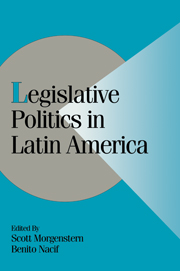Book contents
- Frontmatter
- Contents
- Tables and Figures
- Contributors
- Preface and Acknowledgments
- Party Names and Other Acronyms and Abbreviations
- 1 TOWARDS A MODEL OF LATIN AMERICAN LEGISLATURES
- Part I Executive–Legislative Relations
- Part II Political Parties and Legislative Structure
- Part III Legislatures and the Policy Process
- Part IV Conclusions
- 14 EXPLAINING LEGISLATIVE POLITICS IN LATIN AMERICA
- 15 EPILOGUE: LATIN AMERICA'S REACTIVE ASSEMBLIES AND PROACTIVE PRESIDENTS
- References
- Author Index
- General Index
14 - EXPLAINING LEGISLATIVE POLITICS IN LATIN AMERICA
Published online by Cambridge University Press: 14 January 2010
- Frontmatter
- Contents
- Tables and Figures
- Contributors
- Preface and Acknowledgments
- Party Names and Other Acronyms and Abbreviations
- 1 TOWARDS A MODEL OF LATIN AMERICAN LEGISLATURES
- Part I Executive–Legislative Relations
- Part II Political Parties and Legislative Structure
- Part III Legislatures and the Policy Process
- Part IV Conclusions
- 14 EXPLAINING LEGISLATIVE POLITICS IN LATIN AMERICA
- 15 EPILOGUE: LATIN AMERICA'S REACTIVE ASSEMBLIES AND PROACTIVE PRESIDENTS
- References
- Author Index
- General Index
Summary
Instead of focusing on presidents, militaries, financial sector bureaucrats, or social actors, the preceding pages have placed the Argentine, Brazilian, Chilean, and Mexican legislatures at the center of democratic politics. While the authors all agree that the legislatures are potent, it is also clear that the legislatures take a less proactive role than does the U.S. Congress. In this chapter I draw on the previous chapters to argue that the legislatures take a generally reactive role, but within this role there is great variance in the way in which the legislatures assert their power and insert themselves into the policy process. I argue further that the chapters have also offered significant evidence that, as postulated in the introduction, many of the differences are explicable by institutional variation.
The country chapters are arranged to focus on substantive questions about executive–legislative relations and the role of parties in organizing the business of the legislature. In this conclusion I return to the thematic questions raised in the introduction about the importance of reelection rates, electoral systems, partisan alignments, and constitutional powers on legislative politics. In doing so, this chapter has two primary goals. First, a main methodological strategy of this book has been to borrow from the U.S. model in deriving descriptions of key pieces of the legislative process and explanations for legislative behavior in Latin America. But, we have also shown that the assumptions embedded in models of the U.S. Congress must become variables in a comparative context.
- Type
- Chapter
- Information
- Legislative Politics in Latin America , pp. 413 - 445Publisher: Cambridge University PressPrint publication year: 2002
- 26
- Cited by



